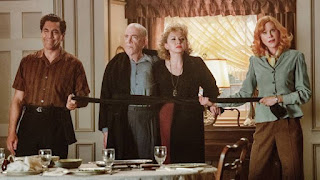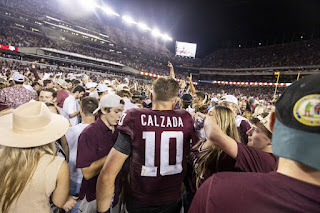For the five decades I’ve watched Texas Aggie football, for at least the first four of them, it never seemed like big business, a corporation, or anything other than a wonderful opportunity for young men with skill to earn a college education and potential gain entry to the NFL, with substantive hard work, sacrifice and difficult training. [Photo credit: 247sports.com]
During the days of Bear Bryant and Gene Stallings, Aggies gave their all for their coaches. Quarterbacks, tight ends, running backs, and many other players would limp back into the lineup after having been crushed and ground and left for roadkill under a bruising opponent. If they were going to leave a game, it would be on a stretcher.
It was the heart and soul of the Aggie spirit to “give your all” for your team, your teammates, and your school. The 12th Man stood in every space in the student section on the ready, having been taught by tradition what it meant, and cost, to be a part of the proud 12th Man tradition. That was before concussion protocols were developed. Times have changed.
It was disheartening to read the various headlines on social media surrounding Zach Calzada’s decision to enter the transfer portal. To wit:
Houston Chronicle Sports
Zach Calzada is entering the transfer portal and won't play in the Gator Bowl, potentially leaving Texas A&M Football without a healthy scholarship quarterback.
Texas A&M Aggies Football Fans (not an official Aggie affiliated page)
Calzada isn't a fit with the Aggies anymore, but he'll generate interest elsewhere.
San Antonio Express-News
That leaves the Aggies potentially without a healthy scholarship quarterback against Wake Forest in the Gator Bowl.
This after just two weeks ago reading the TexAgs.com laudatory post regarding the “almost win” vs. LSU:
“After a tough, 3-TD performance that included two second-half scoring drives to give the Aggies the lead, quarterback Zach Calzada is this week's Overnight Sensation:”
And that, just 9 weeks after the first loss Alabama has had since 2019, under the arm of Zach Calzada, the hero of the night, the week, and the next 56 or so days….until the loss at LSU. [Photo credit: KBTX.com]
All of a sudden, people began inquiring as to the health of Haynes King, the former starting quarterback, and then there was the news story about the Aggies signing of a premiere 5-star prospect, yada yada.
And just like that, yesterday’s hero is an afterthought; no mention of Zach Calzada or his future potential as a quarterback who’d been not only a successful backup who led the team with dignity this year, but a true 12th Man who came in and took not one, not two, not three, but multiple beatings, both on and off the football field.
Yesterday’s news and then today, a guy, who according to some headlines, left A&M without a starting quarterback for the “big” bowl game coming up. I think I’ve seen it all now.
Has social media really created all the ingrates or it is instead a place where bullies who buy the Aggie hats get to join in and pile on when someone wants to rag on the one they decided is the cause of all their problems?
It was never this way in the old days—yes, there was the “what have you done for us lately?” attitude in sports, but it was never as visceral. Back then, there was no Facebook, Instagram, TikTok, or other instant means of trashing a person, instantly, as there is today. Players back then were different, too.
Under Emory Bellard, in the 70s, the top football players were also on the (then) GTE (today Verizon) Southwest Conference for Academic All-Americans as well as for football prowess. Ed Simonini ’78, Civil Engineering master’s, Baltimore Colts, Bubba Bean, ’75, Industrial Education grad, Atlanta Falcons, and the tradition of academic strength continued.
Under R.C. Slocum we had more of the same, and then many players found their way into the NFL and would return after their pro careers to get their degrees and get on with life.
We’ll skip Dennis Franchione and zip right to Coach Jimbo Fisher. Pluses about Jimbo include his inevitable good humor, willingness to appear on TV commercials and support anything that brings Aggies to Kyle Field, and he can brighten any game loss with his smiles and promises that the next week, the team will execute the plan and get back on track and get down to business and make all those working parts come together and be the team he knows they can be.
All season long the Aggies had highs and lows, and yet we weren’t breaking through to beat teams we should have handled easily. That’s the “any given Saturday” reason, because some teams simply aren’t as bad as their antagonists think. Others have reputations that far exceed their abilities.
The Aggies bring heart and soul to every game they play and there’s those 12th Man kids in the stands, screaming their heads off for the Aggies to win. Aggies never lose, they’re only outscored.
This season, though, reminded me a little too much of Coach Fisher’s final season at Florida State. Back then, he had the future Heisman Trophy winner to be in the media crosshairs because of some “youthful indiscretions” and “personal matters” that if you actually took the time to read the constant details of the “indiscretions,” well, you wouldn’t be impressed.
No matter how many times he got in trouble, he was the QB leading the #1 team in the nation and was a shoe-in for the Heisman. Jimbo tolerated, placated, and kept talking and they won the national title and the wild child won the Heisman. Win-win, right? Or not.
Before this season started, two Aggie football players got in some “trouble” and the infraction for one of them was such that there was a question whether he would play this season. After a one-game suspension the young man was allowed to play and did pretty well for the team, and the football press called it his “offseason personal matters” that he’d be dealing with after the season was over.
But of course. Two weeks ago, the local paper ran a laudatory article about that player being a mentor for the younger players this season, advising them on learning from his mistakes because he'd really grown up (in 12 weeks). Fine, fine.
Sadly, if you can do something to help the school win a football game, you are golden. It’s hands-off, we love ‘em, and it’s probably always the way it’s been. It’s just that no one talks about it out loud. If you question it, you will hear from social media that you are a “2-percenter” or a “bad Aggie” or “a hater,” a term that came to life during the Johnny Manziel era, where people who questioned his off-the-football field antics were considered haters and “good” Aggies hated the haters and loved their Johnny Football.
Except for one thing. Had any coaches been able to look past their win/loss record to bring some stability and reality into his world, that young man might still be playing professional football today, as he had unparalleled spirit, talent, and a desire to win.
After he left, and his pro days played out in the media, Aggies welcomed him back for a while, and today, whenever he’s in town, it’s only his true friends who welcome and honor him for being the guy who not only beat Alabama, but who got the Aggies positioned to even seriously consider dreams of the national championship. Alabama is in his rearview mirror, though he graciously did a social media shout-out to Calzada when his never-say-die play led the Aggies to victory.
Zach Calzada made a good choice in entering the transfer portal.
Just as Kyler Murray proved out who he was at TCU, and a Heisman Trophy later, he continues to start for the Atlanta Falcons each week, and A&M is a distant memory in his rearview mirror. Players these days are fortunate to have parents or mentors as advocates looking ahead for their young proteges.
Any “fans” who slammed Zach on social media might read what he posted in response to the slams, excerpted from the edited version on Instagram:
“The overwhelming majority of the 12th Man has given me unwavering support. In exchange I gave you my left ankle against Mississippi State, my left knee against Alabama and my left shoulder against Auburn & again last night, and I will continue to give everything for this team and this University.”
It’s painful to recall watching the injuries Zach sustained, possibly at the inexperience of his offensive line. That we got a bowl game this year, despite his injuries, can be summed up to his willingness to “step into the medical tent,” followed by a worried Jimbo Fisher.
One can only imagine Fisher’s angst as he wondered about the well-being of his player and the outcome of the game that remained to be played. That’s why they pay the big bucks to the coach, to balance their judgments as to when to pull a player or play one who’s been injured a little bit longer.
Each time Zach came out of the tent and resumed play; one can only wonder what pain he had to live through the rest of the week, after the miracle patching up he received in the tent, only to have another injury come his way in subsequent weeks. The adrenaline rush of playing to win surely saw him through the rest of those games. But the minute you might not be useful to the team..."next in line!"
Zach made his choice yesterday, and it was the right one for him, and he’ll be fine after shoulder surgery (he wouldn’t have been able to play in the Bowl game anyway, so he didn’t “leave A&M without a quarterback”). He's been on the sidelines all year as backup and you'll see him in the bowl game. The school that chooses Calzada will benefit from his experience and skills learned this year. Will A&M constantly be chasing that rainbow of the national championship? Yes.
Will Aggies continue to support their team and be the true 12th Man through both wins and being outscored? If the traditions have lasted this long, hopefully they can last a little longer. But will A&M continue to perpetuate a culture that allows cyberbullies to challenge the resounding swell of the 12th Man? One can hope that will go away sooner than later.























